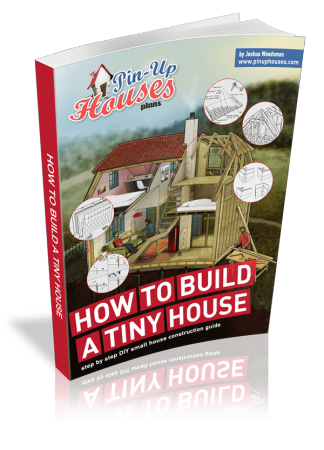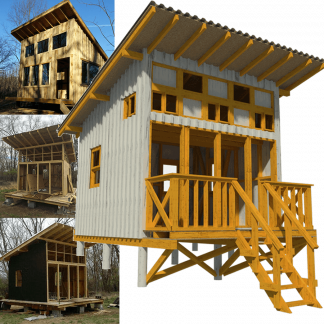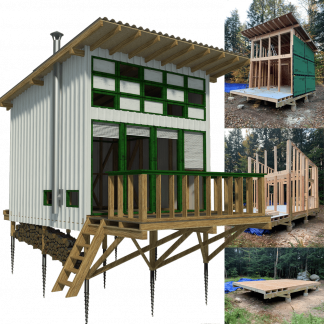The Unique Challenges of Small Home Design
Designing a small home isn’t just about making things fit. It’s about making every inch work harder—visually, acoustically, and functionally. Ceilings are often overlooked in this equation. But in compact spaces, the ceiling is prime real estate. It shapes how a room feels and sounds.
In smaller homes, especially tiny cabins or ADUs, ceiling design can make the difference between feeling open or cramped, calm or chaotic. Low ceilings can make rooms feel boxed in. Thin ones can amplify sound from footsteps or plumbing. This is where smart ceiling choices matter most.
Why Ceiling Choice Matters More in Compact Spaces
In larger homes, ceiling height and structure are often overlooked. But in smaller spaces, they’re front and center—literally. You see them more, hear more through them, and have fewer places to hide mechanical systems. Whether you’re converting a shed into a guest house or finishing a loft above a garage, what’s above your head deserves attention. When planning a remodel or DIY build, many homeowners start by searching for practical materials and suppliers. That often means typing in things like “drop ceiling suppliers near me” to find options that are affordable, functional, and easy to install. But not all ceiling systems are equal—especially when space and sound matter.
Popular Ceiling Types for Small Homes
Traditional Drywall Ceilings
This is the default for most builders. It’s affordable, fire-resistant, and gives a clean finish. But in small homes, drywall ceilings can be limiting. They make it harder to access wiring or plumbing later. Additionally, they don’t offer much in terms of noise reduction unless paired with insulation.
Drop Ceiling Systems
Drop ceilings—also known as suspended ceilings—used to be a staple of offices and basements. However, modern versions are making a comeback in residential spaces, particularly in small ones. They let you hide pipes, wiring, and ductwork without sealing everything off permanently. And when done right, they look sharp and contemporary.
Drop ceilings also offer serious soundproofing potential. With acoustic tiles and sound-absorbing materials, they can block noise from upstairs or between floors—something that’s critical in tiny homes with loft bedrooms or stacked spaces.
Exposed Beam Designs
Exposed beams can give a rustic, open feeling, especially in cabins or shed conversions. They add character and draw the eye upward, creating a sense of height. But be aware: they can also reflect sound. Pair them with acoustic panels or insulation above the ceiling line to reduce echo.
Vaulted and Cathedral Options
If your structure allows it, raising the roofline can work wonders in a small home. Vaulted ceilings add air and light, making even a 400-square-foot cabin feel expansive. They also create opportunities for clerestory windows or overhead storage. Just keep in mind that sound travels. High ceilings need thoughtful materials to prevent echo and noise bounce.
Maximizing Vertical Space Through Smart Ceiling Design
Creating Storage Solutions Above
In a small home, storage isn’t a luxury—it’s survival. The ceiling can help. Think built-in shelves near the top of walls, lofted platforms, or even ceiling-mounted racks in kitchens or bathrooms. A flat ceiling with proper support makes it easier to add these elements safely. Drop ceilings with removable tiles also allow you to incorporate shallow storage or lighting tracks without compromising access.
Integrating Lighting and Utilities
Lighting matters more when space is tight. Instead of bulky fixtures, consider recessed lighting or LED strip lights integrated into the ceiling for a sleeker look. Drop ceilings are especially useful for this—you can hide wiring and access it later without tearing anything out. Want a ductless HVAC system or a vent hood that disappears when not in use? A smart ceiling layout makes that possible.
Visual Tricks to Increase Perceived Height
Color and texture can transform how a ceiling feels. Glossy or light-painted ceilings reflect more light, making the room feel taller. Vertical shiplap or beadboard can draw the eye upward. Even framing around recessed lights or using contrast between ceiling and wall color can visually expand the space. In tiny homes, these tricks go a long way toward making tight rooms feel breathable.
Sound Control in Multi-Level Small Homes
Understanding Noise Transfer Between Floors
If your small home has a loft or stacked layout, sound can become a daily nuisance. Footsteps dropped objects, and plumbing noise easily travels through thin ceiling layers. Without proper treatment, every move upstairs can be heard below—and vice versa.
Acoustic Insulation Materials and Techniques
Effective sound control begins within the ceiling cavity. Use mineral wool or dense fiberglass batts between joists to absorb sound. If you’re using drywall, consider adding a second layer with Green Glue in between. For more advanced setups, resilient channels can help decouple drywall from framing, cutting down on vibration transfer.
Drop Ceiling Soundproofing Benefits
Drop ceilings shine here. Acoustic tiles don’t just look clean—they actively reduce sound transmission. You can layer additional insulation above the grid or use high-NRC (Noise Reduction Coefficient) tiles for even better results. It’s one of the simplest ways to improve sound privacy in a compact layout, especially when retrofitting older spaces.
Combining Aesthetics with Noise Reduction
It doesn’t have to be a trade-off. Stylish drop ceiling tiles like those on decorativeceilingtiles.net, wood-look panels, or textured acoustic solutions give you both form and function. Exposed beam ceilings with integrated sound-absorbing panels can maintain a rustic look while reducing echo. Even vaulted ceilings can be fitted with discreet acoustic baffles to tame reverb.
Making the Right Choice for Your Small Home
In small-space design, ceilings are a big deal. They impact storage, comfort, light, and sound. Traditional drywall is suitable if the budget is tight, but drop ceilings offer greater flexibility and sound control. Exposed beams give charm, while vaulted ceilings bring light and air—but each comes with trade-offs.
The right ceiling for your space depends on how you live, what you need to hide or reveal, and how much sound privacy is important to you. Plan with intention, choose smart materials, and don’t be afraid to search out “drop ceiling suppliers near me” or consult with pros when you need the best mix of form and function.








